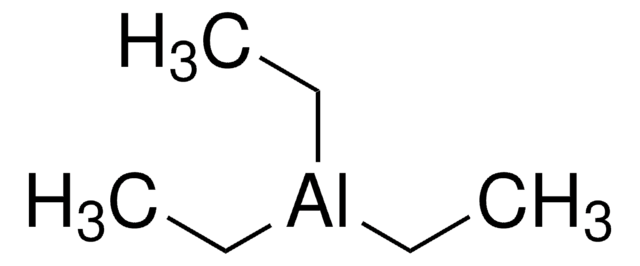663301
Trimethylaluminum
packaged for use in deposition systems
Synonym(s):
Aluminum trimethanide, TMA
About This Item
Recommended Products
vapor pressure
69.3 mmHg ( 60 °C)
Quality Level
description
heat of vaporization: ~41.9 kJ/mol (Dimer)
form
liquid
reaction suitability
core: aluminum
bp
125-126 °C (lit.)
127 °C/760 mmHg
20 °C/8 mmHg
56 °C/50 mmHg
mp
15 °C (lit.)
density
0.752 g/mL at 25 °C (lit.)
SMILES string
C[Al](C)C
InChI
1S/3CH3.Al/h3*1H3;
InChI key
JLTRXTDYQLMHGR-UHFFFAOYSA-N
Looking for similar products? Visit Product Comparison Guide
General description
Application
- A chemical vapor deposition precursor to fabricate PbSe quantum dot solids for optoelectronic devices.
- An aluminum precursor for the flame synthesis of alumina nanofibers.
- A reagent for efficient synthesis of allenes.
signalword
Danger
hcodes
Hazard Classifications
Eye Dam. 1 - Pyr. Liq. 1 - Skin Corr. 1B - Water-react 1
supp_hazards
Storage Class
4.2 - Pyrophoric and self-heating hazardous materials
wgk_germany
nwg
flash_point_f
No data available
flash_point_c
No data available
ppe
Faceshields, Gloves, Goggles, type ABEK (EN14387) respirator filter
Choose from one of the most recent versions:
Already Own This Product?
Find documentation for the products that you have recently purchased in the Document Library.
Customers Also Viewed
Articles
Atomic layer deposition (ALD) showcases innovation in novel structure synthesis, area-selective deposition, low-temperature deposition, and more.
Atomic layer deposition meets various needs including semiconductor device miniaturization and nanoparticle coating.
Atomic Layer Deposition (ALD) technology ensures uniform coating on complex 3D surfaces with precise chemisorption cycles.
Nanocomposite Coatings with Tunable Properties Prepared by Atomic Layer Deposition
Our team of scientists has experience in all areas of research including Life Science, Material Science, Chemical Synthesis, Chromatography, Analytical and many others.
Contact Technical Service









